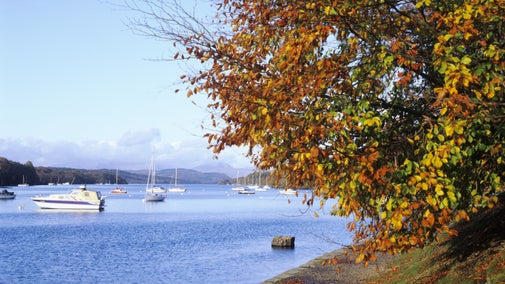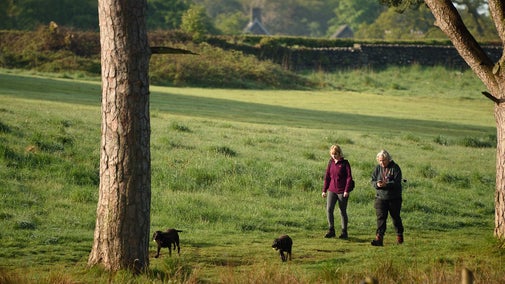
Discover more at Fell Foot
Find out how to get to Fell Foot, where to park, the things to see and do and more.

Fell Foot was once the dramatic setting for a prestigious Lake District villa and has been significant as a recreational estate for over two centuries. It has had a succession of wealthy owners who have all made their mark.
In this podcast Harvey Wilkinson, the National Trust’s Cultural Heritage Curator for the Lake District, takes us on a journey from the turn of the 18th Century when Fell Foot was a private estate to the post war years when the Trust was bequeathed the parkland and for 40 years it was a popular chalet and caravan site, where children brought Ransome’s Swallows and Amazons to life.
In ancient times, Fell Foot was the only place to cross Lake Windermere’s southern end from Kendal to the Furness Abbey lands, and by the early 18th century the site had become a prosperous farm. Around 1784, it was sold by yeoman farmers the Robinsons to Jeremiah Dixon, a Leeds merchant, and his wife Mary, daughter of the Leeds engineer John Smeaton of Eddystone lighthouse fame.
The Dixons enlarged the farmhouse into a substantial villa overlooking the lake and laid out a pleasure ground, moving the public road in about 1810, from the lakeside to the landward side of the house. In so doing, they created one of the earliest classic villa landscapes of the Lake District.
The now highly desirable gentleman’s family residence at Fell Foot was sold by the Dixons in 1813 to Francis Dukinfield Astley Esq. (1781–1825) of Dukinfield Lodge, near Manchester. Known as Squire Astley, he had profited greatly from coal mining at Dukinfield and brought to Fell Foot not only a fortune, but a significant interest in forestry, publishing The Planter’s Guide in 1814. He was also famous as a huntsman, with his own pack of harriers and was a published romantic poet.
Fell Foot's new owner in 1859 was Colonel George John Miller Ridehalgh (1835–92), lord of the manor of Urmston, near Manchester. Like Squire Astley, he was a keen sportsman who kept a pack of foxhounds, the Windermere Harriers. He also had a passion for sailing, which he indulged on a grand scale.
The estate reached the peak of its development under Ridehalgh. He planted an arboretum of deciduous trees and exotic conifers and laid out shrubberies of rhododendrons within the open lawns of the paddocks to optimise the mountain and lake views. Rhododendron bushes were very fashionable at the time and well suited to the soil in the area.
Ridehalgh also extended the walled kitchen garden, completed stables and kennels, reworked the interior of the house and lit the entire estate with coal gas, generated on site.

The most enduring element of the improvements he made to the estate is the small harbour complex of three piers and five Gothic boathouses, complete with crenelated turrets, arrow loops, doorways and rustic limestone decoration – all designed to be viewed from the lake.
The boathouses relate architecturally to others on Windermere, particularly the earlier and larger example at Wray Castle. However, the extent of the Grade II complex at Fell Foot is among the best in the Lake District.
The end of the Ridehalgh era came in 1907, when the Colonel’s cousin George died and the estate was sold to Oswald Hedley (1884–1945). Hedley demolished the house and started to build a neo-Jacobean mansion, which had risen no higher than the cellars before his wife died in 1909 and he virtually abandoned Fell Foot for the rest of his life.
In 1948, his widow and third wife, Mrs E.L. Hedley, gave the 18 acres between the road and the lake to the National Trust in her husband’s memory. The recreational use of Fell Foot enjoyed by thousands of visitors today began at this point, initially with a 21-year lease to Mr P.L. Rhodes to use the site for camping and caravanning.
In 1969, the Trust took over running Fell Foot as a country park. It was the first in the Lake District to be designated as such under the Countryside Act of 1968, which provided government aid to set the facilities necessary for outdoor recreation. The park opened in 1972 with 19 holiday chalets in the woodland, facilities for touring caravans in the former walled garden and a car park on the site of the house.
Fell Foot is important as one of the very few lakeside venues accessible to the public south of Bowness, and there remains the potential to restore the historic landscape to the splendour of its Victorian heyday.
Thanks to generous support from the Heritage Lottery Fund, Fell Foot has restored three historic boathouses on the lakeshore.
– Kelley Sproston-Heath, Volunteering and Community Involvement Manager
Since starting Fell Foot’s Oral History Project in October 2018, locals and visitors have sent in photos and anecdotes about memories of their time at Fell Foot, from playing in the ruins of the demolished house and abandoned parkland in the 1940s, to camping and caravanning in the 60s and 70s.
It’s helped to build a vibrant picture of what the park was like and how it’s changed over the years. The team want to find out more and retell some of the stories to today’s visitors through guided tours, interpretation panels and events. Their aim is to eventually build up an archive of recorded interviews to store in the British Library’s Sound Archive.
That’s where you come in; have you got memories of the park, particularly from the time after it was gifted to the National Trust in 1948? Interviewees have come from as far away as the Outer Hebrides and New Zealand. Others are a lot closer to home, including staff who now work here because of childhoods spent in the park.

Find out how to get to Fell Foot, where to park, the things to see and do and more.

Discover how the support from Heritage Fund has helped us to restore Fell Foot to its original Victorian design and find out how we care for this beautiful part of the Lake District.

Take a leisurely walk around the park and meadows and keep an eye out for wildlife including otters, warblers and geese. There's plenty of things to do at Fell Foot.

Fell Foot is the perfect place to try out a new activity on Windermere, England's largest lake. With access to the water, the park is ideal for paddling, canoeing and boat hire. See what’s on offer.

Whether you're after a coffee to take with you on your walk, brunch or an ice cream treat mid-adventure, you'll be well catered for at Fell Foot.

Fell Foot is a three pawprint rated place. Find out all you need to know about exercising your four-legged friends around the parkland, Windermere’s lakeshore and the south meadow.

From buggy-friendly lakeshore walks to Gothic boathouses to explore and England’s largest lake to splash in, there’s something for all ages at Fell Foot, Windermere.

Learn about people from the past, discover remarkable works of art and brush up on your knowledge of architecture and gardens.